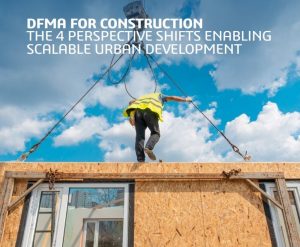The following article is excerpted from DFMA for Construction: The 4 Perspectives Shifts Enabling Scalable Urban Development, a whitepaper developed by Dassault Systèmes. To read more, download the full whitepaper here.
Evolving urban development challenges are driving construction teams to embrace new methods of approaching design and construction. The major forces at work include a shortage of skilled labor, high demand and liability for safety and quality.
Widespread skilled labor shortages
Skilled labor shortages are hampering many industries, construction notably among them.
The Associated General Contractors of America (AGC) reported in January 2020 that more than four out of five respondents were challenged to fill positions in 2019. As a direct result of hiring challenges, 44% of AGC’s survey respondents saw costs rise which resulted in higher prices into upcoming bids. While these statistics are specific to the United States, the challenge is not: Developers worldwide need to look at new methods to deliver products to market in the face of a lack of skilled tradespeople.
A critical need for mid-market housing and healthcare facilities
Demand for new facilities is far outpacing supply in two critical sectors.
First, access to affordable housing continues to worsen, approaching crisis levels. The McKinsey Global Institute predicts that by 2025 the number of urban households living in substandard housing, or so financially stretched by housing costs that they forego other essentials, could grow to 440 million, affecting 1.6 billion people. Even as governments and developers adopt new strategies to match housing supply with demand, many occupants struggle to make payments. Urban planners continue to seek new strategies to lower prices through more efficient construction processes, without sacrificing quality.
Second, the healthcare industry is in the midst of a dramatic transformation. Care is being increasingly driven to a diverse range of outpatient models, moving away from the centralized hub around the hospital. Even as health systems rapidly add facilities to their real estate portfolios, they’re working to upgrade critical systems to prepare for the wave of aging Baby Boomers which will soon have a massive impact on healthcare utilization. Each of these strategies depends on rapid delivery to market at a low cost for health systems and hospitals to stay afloat financially.
Pressure to adhere to manufacturing standards of component traceability
In parallel, designers are experimenting with more complex designs and new materials – ranging from cross-laminated timber to fiberglass-reinforced polymer cladding. With experimentation comes an increased risk that materials or components may fail. If a component does not perform as expected, traceability gives building owners immediate insight as to what structures are at risk. Through traceability, safety issues can be identified, disasters are prevented, and designers can feel more secure in creative project delivery.
Excerpted from DFMA for Construction: The 4 Perspectives Shifts Enabling Scalable Urban Development, a Dassault Systèmes whitepaper
Download our free whitepaper to learn more about.

DfMA has the potential to transform the construction industry. This transformation will gain traction as project stakeholders increasingly discover the cost and time savings DfMA offers. Shifting to modular assemblies demands an initial investment in time spent reengineering processes and the tools and equipment needed to support new components. Companies that lead the change will see greater long-term benefits than those who try to catch up on the later side of the adoption curve.
Related links:
Dassault Systèmes Construction, Cities & Territories Industry
